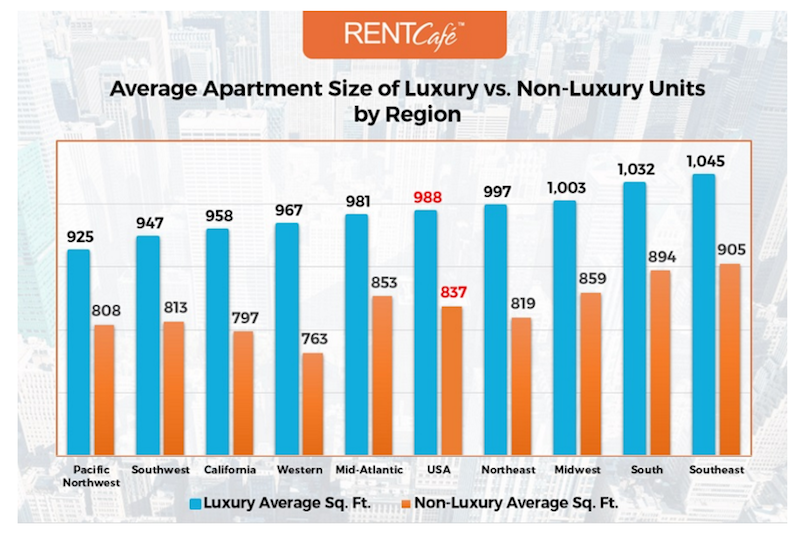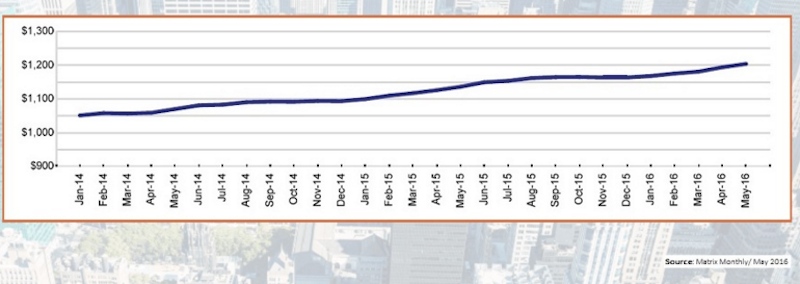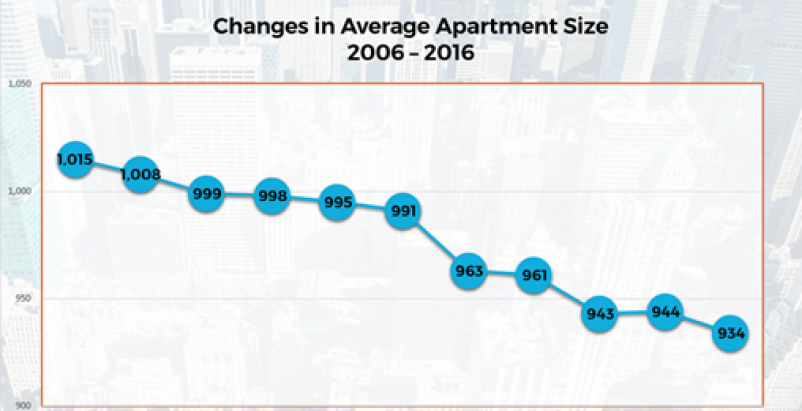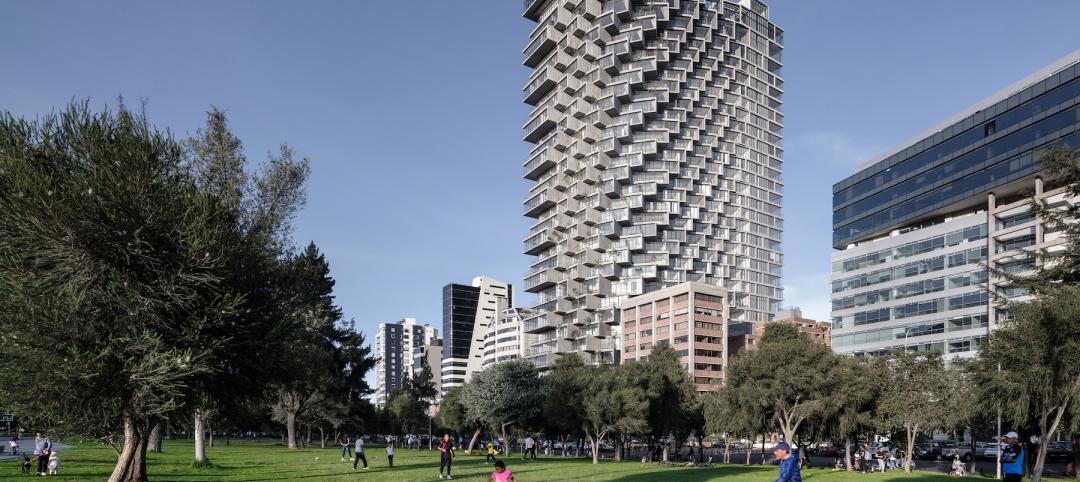The average new apartment in the U.S. is about 8% smaller than the average was a decade ago. And that shrinkage wasn’t confined to urban markets, either.
Those are two of the main findings in a recent survey of the apartment market, conducted by RENTCafé, a nationwide apartment search website, using data provided by Yardi Matrix, a sister company that researches and reports on multifamily properties of 50 units or more across 121 markets in the U.S.
That research shows the size of new apartments averaging 934 sf, versus 1,015 sf in 2006. New studio apartments took the steepest decline, to an average 504 sf this year from 614 sf a decade ago, representing a nearly 18% difference. New two-bedroom apartments, on the other hand, at 1,126 sf, are actually 1% larger than the average for that apartment type in 2006.
RENTCafé estimates that the average apartment size in the U.S., regardless of when it was built, is 889 sf. There are three regions of the country that exceed the average—the Southeast (974 sf), South (937), and Mid-Atlantic (891).

The southern regions of the U.S. still give renters the most for their buck, in terms of average apartment size. Image: RENTCafe
The largest gap between luxury and non-luxury apartment sizes is in the western states, 967 sf vs. 763 sf. Conversely, the gap between luxury and non-luxury apartments in the Southeast is relatively narrow: 1,045 sf vs. 905 sf.
Atlanta leads all cities with the largest average apartments, followed by Plano, Texas; Jersey City, N.J.; Henderson, Nev.; and Chesapeake, Va. Arizona has three of the five cities—Tucson, Glendale, Mesa—with the smallest average apartment sizes. (El Paso, Texas, and Buffalo, N.Y., fill out that ranking).
By far, Atlanta leads all cities with the largest average two-bedroom apartments, at 1,125 sf; Jersey City is its closest rival in that category, at 1,097 sf.
Interestingly, neither New York, San Francisco, nor Boston—three cities where the micro apartment crae hit first—ranks among the top 20 cities for smallest apartment size. (In fact, Boston is No. 10 in among the cities with the largest average apartments.)
“But that doesn’t erase the fact that Manhattan remains the nation’s tightest market, with average rents reaching a whopping $4,043 per month, more than three times the national average,” Yardi Matrix data show.
RENTCafé’s survey breaks down 95 metros and their average apartment sizes by studio, one-bedroom, and two-bedroom. In Los Angeles, the country’s largest city, a studio apartment averages 524 sf, a one-bedroom 729 sf, and a two-bedroom 1,043 sf. Reno, Nev., has the smaller average studios (352 sf), Stockton, Calif., the smaller average one-bedroom (632 sf), and Buffalo the smallest average two-bedroom (843 sf).

Despite the shrinkage in apartments, rents aren't retreating. Image: RENTCafe
The survey cautions, however, that while apartments are shrinking, their rents may not be. “Apartment rents are breaking record after record,” with the national monthly rent hitting an average of $1,204 in May, the report states. In San Francisco, “you’ll still be paying $2,500 for a 500-sf studio.”
There is increasing demand for high-density housing with mixed-use components, which are being directed specifically at Millennials and downsizing Baby Boomers.
Another thing that hasn’t changed: Renters desire apartment buildings with lots of amenities. RENT Café points to Eastown, the largest apartment community delivered to L.A.’s rental market last year. Located in Hollywood, the community includes a pool and spa with lounges, a fireplace and patio area, a gym and fitness center, and electric vehicle charging stations. Rents start at $1,925 for a 571-sf apartment.
 The average size of a new apartment in the U.S. has been on a steady decline for the past 10 years, according to a new survey that tracks apartment sizes in most major metros across the country. Image, which shows average square footage by year: RENTCafe
The average size of a new apartment in the U.S. has been on a steady decline for the past 10 years, according to a new survey that tracks apartment sizes in most major metros across the country. Image, which shows average square footage by year: RENTCafe
Related Stories
Coatings | Dec 20, 2022
The Pier Condominiums — What's old is new again!
When word was out that the condominium association was planning to carry out a refresh of the Pier Condominiums on Fort Norfolk, Hanbury jumped at the chance to remake what had become a tired, faded project.
Cladding and Facade Systems | Dec 20, 2022
Acoustic design considerations at the building envelope
Acentech's Ben Markham identifies the primary concerns with acoustic performance at the building envelope and offers proven solutions for mitigating acoustic issues.
Self-Storage Facilities | Dec 16, 2022
Self-storage development booms in high multifamily construction areas
A 2022 RentCafe analysis finds that self-storage units swelled in conjunction with metros’ growth in apartment complexes.
Sponsored | Resiliency | Dec 14, 2022
Flood protection: What building owners need to know to protect their properties
This course from Walter P Moore examines numerous flood protection approaches and building owner needs before delving into the flood protection process. Determining the flood resilience of a property can provide a good understanding of risk associated costs.
Sponsored | Multifamily Housing | Dec 14, 2022
Urban housing revival: 3 creative multifamily housing renovations
This continuing education course from Bruner/Cott & Associates highlights three compelling projects that involve reimagining unlikely buildings for compelling multifamily housing developments.
Multifamily Housing | Dec 13, 2022
Top 106 multifamily housing kitchen and bath amenities – get the full report (FREE!)
Multifamily Design+Construction's inaugural “Kitchen+Bath Survey” of multifamily developers, architects, contractors, and others made it clear that supply chain problems are impacting multifamily housing projects.
Mixed-Use | Dec 7, 2022
Bjarke Ingels’ first design project in South America is poised to open next year in Ecuador
In 2013, Quito, Ecuador’s capital, opened its new airport, which had been relocated from the metro’s center to an agricultural site 12 miles northeast of the city. Since then, Quito’s skyline has been reshaped by new, vertical structures that include the 24-story mixed-use EPIQ Residences, designed in the shape of a quarter circle by Bjarke Ingels Group (BIG).
High-rise Construction | Dec 7, 2022
SOM reveals its design for Singapore’s tallest skyscraper
Skidmore, Owings & Merrill (SOM) has revealed its design for 8 Shenton Way—a mixed-use tower that will stand 63 stories and 305 meters (1,000 feet) high, becoming Singapore’s tallest skyscraper. The design team also plans to make the building one of Asia’s most sustainable skyscrapers. The tower incorporates post-pandemic design features.
Multifamily Housing | Dec 7, 2022
Canada’s largest net-zero carbon residential community to include affordable units
The newly unveiled design for Canada’s largest net-zero carbon residential community includes two towers that will create a new destination within Ottawa and form a striking gateway into LeBreton Flats. The development will be transit-oriented, mixed-income, mixed-use, and include unprecedented sustainability targets. Dream LeBreton is a partnership between real estate companies Dream Asset Management, Dream Impact, and local non-profit MultiFaith Housing Initiative.
Student Housing | Dec 7, 2022
Cornell University builds massive student housing complex to accommodate planned enrollment growth
In Ithaca, N.Y., Cornell University has completed its North Campus Residential Expansion (NCRE) project. Designed by ikon.5 architects, the 776,000-sf project provides 1,200 beds for first-year students and 800 beds for sophomore students. The NCRE project aimed to accommodate the university’s planned growth in student enrollment while meeting its green infrastructure standards. Cornell University plans to achieve carbon neutrality by 2035.
















